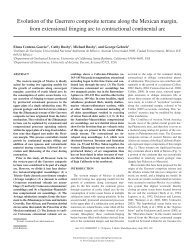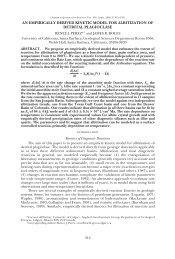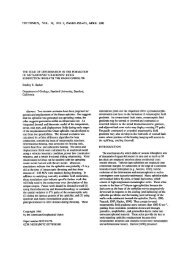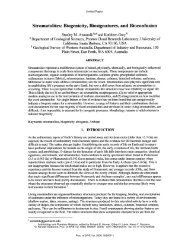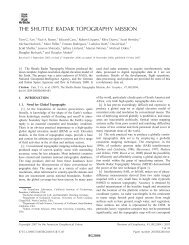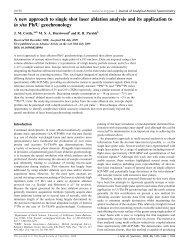Campaign-style titanite U-Pb dating by ICP - Earth Science ...
Campaign-style titanite U-Pb dating by ICP - Earth Science ...
Campaign-style titanite U-Pb dating by ICP - Earth Science ...
Create successful ePaper yourself
Turn your PDF publications into a flip-book with our unique Google optimized e-Paper software.
100 K.J. Spencer et al. / Chemical Geology 341 (2013) 84–101distribution of all leucosome dates suggests that melting began in thecenter of the study area and ended along the outer coastline. 3) Titanitesin the gneiss have similar dates to those from the leucosomes, althoughsome of the gneiss <strong>titanite</strong>s are a bit older (perhaps reflecting inheritance)and some are a bit younger, perhaps due to subsolidus recrystallization.4) Local amphibolite-facies mylonitization began at ~399 Ma and continuedthrough ~377 Ma; these <strong>titanite</strong>s are among the youngest.In aggregate, these data imply a lengthy residence time at crustaldepths (cf. Walsh and Hacker, 2004) during which <strong>titanite</strong> crystallizedin leucosomes, recrystallized <strong>by</strong> reaction with other mineralsor fluids, and recrystallized in response to deformation. This conclusionstands in stark contrast to the short-lived thermal event at395 Ma inferred from the pioneering TIMS <strong>titanite</strong> work of Tuckeret al. (1990).5. Conclusions<strong>Campaign</strong>-<strong>style</strong>, orogen scale <strong>dating</strong> in the Western Gneiss Region ofNorway shows a general gradient in U–<strong>Pb</strong> <strong>titanite</strong> dates from Precambrianto Scandian toward the core of the orogen. The <strong>titanite</strong> U–<strong>Pb</strong>dates do not show a simple relationship among grain size, peak temperature,or cooling rate, implying that thermally mediate volume diffusionwas not the principal factor controlling resetting of the U–<strong>Pb</strong> system.The preservation of Precambrian <strong>titanite</strong> in quartzofeldspathic gneiss inHP and UHP domains means that some <strong>titanite</strong>, and likely 450–750 km 2domains of gneiss, survived the entire 25 Myr long subduction–exhumation cycle; during this period the <strong>titanite</strong> was unstable, butdid not transform to (U)HP minerals and was not deformed. These observationsare further support for the recognition that equilibriumphase transformations and ductile flow of quartzofeldspathic crust attemperatures up to 750 °C cannot be assumed.AcknowledgmentsThe manuscript has been improved <strong>by</strong> comments from KlausMezger, Hannes Brueckner and an anonymous reviewer. Funded <strong>by</strong>EAR-0510453, 0649933, 0911485, and 0923552; the University ofCalifornia, Santa Barbara; and the NFR Centre of Excellence grant toPGP. Håkon Austrheim provided many years of discussion on theimportance of fluids in metamorphism and deformation. A host ofcollaborators participated in sample collection and interpretation:David Root, Emily Walsh, Dave Young, Scott Johnston, Emily Peterman,Jen Schmidt, Stacia Gordon, Steven Arauza and Adam Ginsburg. CraigStorey provided, and Daniel Condon helped analyzed the Ontario-2<strong>titanite</strong> reference material. Ellen Kooijman and Matthijs Smit providedhelpful comments on the manuscript, and Ellen grew the synthetic<strong>titanite</strong> used as an electron probe standard. Frank Mazdab providedunpublished information about the BLR reference material.Appendix A. Supplementary dataSupplementary data to this article can be found online at http://dx.doi.org/10.1016/j.chemgeo.2012.11.012.ReferencesAbers, G.A., Peacock, S.M., Hacker, B.R., 1999. Cool subducted crust at depths greaterthan 100 km: low seismic velocities, mineralogy, and thermal structure. EOS.Transactions of the American Geophysical Union 80.Andersen, T.B., Jamtveit, B., Dewey, J.F., Swensson, E., 1991. Subduction and eduction ofcontinental crust: major mechanism during continent–continent collision andorogenic extensional collapse, a model based on the south Caledonides. Terra Nova3, 303–310.Anderson, D.L., 2007. New Theory of the <strong>Earth</strong>. Cambridge University Press (400 pp.).Austrheim, H., 1987. Eclogitization of lower crustal granulites <strong>by</strong> fluid migrationthrough shear zones. <strong>Earth</strong> and Planetary <strong>Science</strong> Letters 81, 221–232.Austrheim, H., Boundy, T.M., 1994. Pseudotachylytes generated during seismic faultingand eclogitization of deep crust. <strong>Science</strong> 265, 82–83.Beaumont, C., Nguyen, M., Jamieson, R.A., Ellis, S., 2006. Crustal flow modes in large, hotorogens. Geological Society of London Special Publication 268, 91–145.Behn, M.D., Kelemen, P.B., Hirth, G., Hacker, B.R., Massonne, H.J., 2011. Diapirs as thesource of the sediment signature in arc lavas. Nature Geoscience. http://dx.doi.org/10.1038/NGEO1214.Bird, P., 1991. Lateral extrusion of lower crust from under high topography, in the isostaticlimit. Journal of Geophysical Research 96, 10275–10286.Chambers, J.M., Kohn, M.J., 2012. Titanium in muscovite, biotite, and hornblende:modeling, thermometry, and rutile activities of metapelites and amphibolites.American Mineralogist 97, 543–555.Cherniak, D.J., 1993. Lead diffusion in <strong>titanite</strong> and preliminary results on the effects ofradiation damage on <strong>Pb</strong> transport. Chemical Geology 110 (1–3), 177–194.Clark, M.K., Royden, L.H., 2000. Topographic ooze: building the eastern margin of Tibet<strong>by</strong> lower crustal flow. Geology 28, 703–706.Corfu, F., 1996. Multistage zircon and <strong>titanite</strong> growth and inheritance in an Archeangneiss complex, Winnipeg River Subprovince, Ontario. <strong>Earth</strong> and Planetary <strong>Science</strong>Letters 141 (1–4), 175–186.Corfu, F., Andersen, T.B., 2002. U–<strong>Pb</strong> ages of the Dalsfjord Complex, SW Norway, andtheir bearing on the correlation of allochthonous crystalline segments of theScandinavian Caledonides. International Journal of <strong>Earth</strong> <strong>Science</strong> 91, 955–963.Cuthbert, S.J., Carswell, D.A., Krogh-Ravna, E.J., Wain, A., 2000. Eclogites and eclogites inthe Western Gneiss Region, Norwegian Caledonides. Lithos 52, 165–195.Dobrzhinetskaya, L.F., Eide, E.A., Larsen, R.B., Sturt, B.A., Tronnes, R.G., Smith, D.C.,Taylor, W.R., Posukhova, T.V., Posukhova, T.V., 1995. Microdiamond in high-grademetamorphic rocks of the Western Gneiss region, Norway. Geology 23, 597–600.Ellis, S., Little, T.A., Wallace, L.M., Hacker, B.R., Buiter, S.J.H., 2011. Feedback betweenrifting and diapirism can exhume ultrahigh-pressure rocks. <strong>Earth</strong> and Planetary<strong>Science</strong> Letters 311, 427–438.Engvik, A.K., Austrheim, H., Andersen, T.B., 2000. Structural, mineralogical andpetrophysical effects on deep crustal rocks of fluid-limited polymetamorphism, WesternGneiss Region, Norway. Journal of the Geological Society of London 157, 121–134.Frost, B.R., Chamberlain, K.R., Schumacher, J.C., 2000. Sphene (<strong>titanite</strong>): phase relationsand role as a geochronometer. Chemical Geology 172, 131–148.Gao, X.-Y., Zheng, Y.-F., Chen, Y.-X., Guo, J., 2012. Geochemical and U–<strong>Pb</strong> age constraintson the occurrence of polygenetic <strong>titanite</strong>s in UHP metagranite in the Dabie orogen.Lithos 136–139, 93–108.Gerya, T.V., Stöckhert, B., 2006. Two-dimensional numerical modeling of tectonic andmetamorphic histories at active continental margins. International Journal of<strong>Earth</strong> <strong>Science</strong>s 95, 250–274.Glodny, J., Kühn, A., Austrheim, H., 2008. Diffusion versus recrystallization processes inRb–Sr geochronology: isotopic relics in eclogite facies rocks, Western GneissRegion, Norway. Geochimica et Cosmochimica Acta 72, 506–525.Gromet, P.L., 1991. Direct <strong>dating</strong> of deformational fabrics. In: Heaman, L., Ludden, J.N.(Eds.), Applications of Radiogenic Isotope Systems to Problems in Geology. MineralogicalAssociation of Canada, Toronto, pp. 167–189.Hacker, B.R., 1996. Eclogite formation and the rheology, buoyancy, seismicity, and H 2 Ocontent of oceanic crust. In: Bebout, G.E., Scholl, D., Kir<strong>by</strong>, S.H., Platt, J.P. (Eds.),Dynamics of Subduction. American Geophysical Union, Washington, D.C., pp. 337–346.Hacker, B.R., 2006. Pressures and temperatures of ultrahigh-pressure metamorphism:implications for UHP tectonics and H 2 O in subducting slabs. International GeologyReview 48, 1053–1066.Hacker, B.R., Gans, P.B., 2005. Creation of ultrahigh-pressure terranes: the Trøndelag–Jämtland region of the Scandinavian Caledonides. Geological Society of AmericaBulletin 117, 117–134.Hacker, B.R., Kir<strong>by</strong>, S.H., 1993. High-pressure deformation of calcite marble and itstransformation to aragonite under non-hydrostatic conditions. Journal of StructuralGeology 15, 1207–1222.Hacker, B.R., Bohlen, S.R., Kir<strong>by</strong>, S.H., Rubie, D.C., 2005. Calcite –> aragonite transformationin marble: textures and reaction mechanisms of an archetypal polymorphic phasetransformation. Journal of Geophysical Research 110. http://dx.doi.org/10.1029/2004JB003302.Hacker, B.R., Andersen, T.B., Johnston, S., Kylander-Clark, A.R.C., Peterman, E., Walsh,E.O., Young, D., 2010. High-temperature deformation during continental-marginsubduction & exhumation: the Ultrahigh-Pressure Western Gneiss Region of Norway.Tectonophysics 480, 149–171.Harrison, T.M., Celerier, J., Aikman, A.B., Hermann, J., Heizler, M.T., 2009. Diffusion of40Ar in muscovite. Geochimica et Cosmochimica Acta 73, 1039–1051.Hayden, L.A., Watson, E.B., Wark, D.A., 2008. A thermobarometer for sphene (<strong>titanite</strong>).Contributions to Mineralogy and Petrology 155, 529–540.Hori, S., Inoue, H., Fukao, Y., Ukawa, M., 1985. Seismic detection of the untransformed“basaltic” oceanic crust subducting into the mantle. Geophysical Journal of theRoyal Astronomical Society 83, 169–197.Jackson, J.A., Austrheim, H., McKenzie, D., Priestley, K., 2004. Metastability, mechanicalstrength, and the support of mountain belts. Geology (Boulder) 32 (7), 625–628.Jackson, J.A., McKenzie, D., Priestley, K., Emmerson, B., 2008. New views on the structureand rheology of the lithosphere. Journal of the Geological Society of London 165,453–465.Johnston, S., Hacker, B.R., Ducea, M.N., 2007. Exhumation of ultrahigh-pressure rocksbeneath the Hornelen segment of the Nordfjord-Sogn Detachment Zone, westernNorway. Geological Society of America Bulletin 119, 1232–1248.King, J., Harris, N., Argles, T., Parrish, R., Zhang, H., 2011. Contribution of crustal anatexisto the tectonic evolution of Indian crust beneath southern Tibet. Geological Societyof America Bulletin 123 (1–2), 218–239.Kohn, M.J., Corrie, S.L., 2011. Preserved Zr-temperatures and U–<strong>Pb</strong> ages in high-grademetamorphic <strong>titanite</strong>: evidence for a static hot channel in the Himalayan orogen.<strong>Earth</strong> and Planetary <strong>Science</strong> Letters 311, 136–143.



